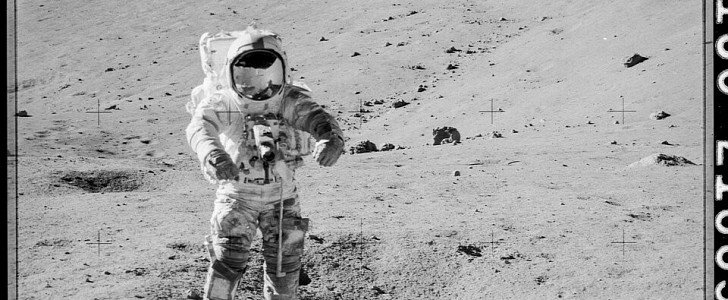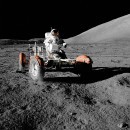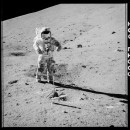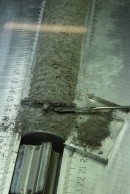The European Space Agency (ESA) will open a container that has inside some “chunks” taken out of our natural satellite during the last Apollo mission. This special gift comes from more than 200,000 miles (~ 321,000 km) away, and it was left untouched for five decades – until now.
The year was 1972 when the Apollo 17 crew was landing in a location called Taurus-Littrow Valley, a region on the Moon located in a mountain range formed by asteroid impacts billions of years ago. Back then, astronaut Gene Cernan slowly moved on the lunar surface to collect samples of the site.
To obtain a core sample of lunar soil, he hammered a 70-cm (27.5-in) long cylindrical tube into the surface. This core sample was enclosed in a vacuum-tight container on the Moon and was returned to Earth.
Once it was brought here, the container was put in another vacuum chamber, where it waited patiently until now. Five decades later, scientists are ready to open this special package, which makes up for an incredible Christmas present.
The researchers believe that the container still has some lunar gases trapped inside that remained undisturbed for dozens of years. To get to their object of interest (well, in this case, gas of interest), they will use a piercing tool built by ESA, which was jokingly called the “Apollo can opener.”
With the help of this “can opener,” the team will puncture the container. The preserved gases will come out slowly and be captured in dedicated canisters. Once the scientists have what they’re looking for, they’ll send the gas sample canisters to laboratories all over the world for an in-depth analysis.
Studying these gases will help researchers better understand the Moon’s geology but provide a great opportunity to explore new “sample handling and containment approaches.” These can further contribute to future Moon missions and the exploration of Mars.
The valuable insight could be used for the Mars Sample Return mission, a project led in collaboration with NASA, which is intended to return samples collected by NASA’s Perseverance rover back to Earth later this decade.
To obtain a core sample of lunar soil, he hammered a 70-cm (27.5-in) long cylindrical tube into the surface. This core sample was enclosed in a vacuum-tight container on the Moon and was returned to Earth.
Once it was brought here, the container was put in another vacuum chamber, where it waited patiently until now. Five decades later, scientists are ready to open this special package, which makes up for an incredible Christmas present.
The researchers believe that the container still has some lunar gases trapped inside that remained undisturbed for dozens of years. To get to their object of interest (well, in this case, gas of interest), they will use a piercing tool built by ESA, which was jokingly called the “Apollo can opener.”
With the help of this “can opener,” the team will puncture the container. The preserved gases will come out slowly and be captured in dedicated canisters. Once the scientists have what they’re looking for, they’ll send the gas sample canisters to laboratories all over the world for an in-depth analysis.
Studying these gases will help researchers better understand the Moon’s geology but provide a great opportunity to explore new “sample handling and containment approaches.” These can further contribute to future Moon missions and the exploration of Mars.
The valuable insight could be used for the Mars Sample Return mission, a project led in collaboration with NASA, which is intended to return samples collected by NASA’s Perseverance rover back to Earth later this decade.






